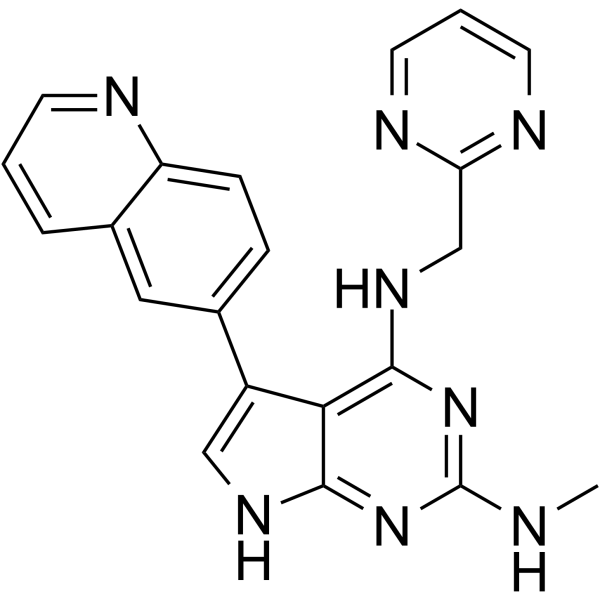Physicochemical Properties
| Molecular Formula | C21H18N8 |
| Molecular Weight | 382.42122220993 |
| Exact Mass | 382.165 |
| CAS # | 2407433-00-3 |
| PubChem CID | 133082038 |
| Appearance | Yellow to green solid powder |
| LogP | 3 |
| Hydrogen Bond Donor Count | 3 |
| Hydrogen Bond Acceptor Count | 7 |
| Rotatable Bond Count | 5 |
| Heavy Atom Count | 29 |
| Complexity | 527 |
| Defined Atom Stereocenter Count | 0 |
| SMILES | N1C=C(C2C=CC3C(=CC=CN=3)C=2)C2=C(N=C(NC)N=C12)NCC1N=CC=CN=1 |
| InChi Key | PMWVYONICYRLNY-UHFFFAOYSA-N |
| InChi Code | InChI=1S/C21H18N8/c1-22-21-28-19-18(20(29-21)27-12-17-24-8-3-9-25-17)15(11-26-19)13-5-6-16-14(10-13)4-2-7-23-16/h2-11H,12H2,1H3,(H3,22,26,27,28,29) |
| Chemical Name | 2-N-methyl-4-N-(pyrimidin-2-ylmethyl)-5-quinolin-6-yl-7H-pyrrolo[2,3-d]pyrimidine-2,4-diamine |
| HS Tariff Code | 2934.99.9001 |
| Storage |
Powder-20°C 3 years 4°C 2 years In solvent -80°C 6 months -20°C 1 month |
| Shipping Condition | Room temperature (This product is stable at ambient temperature for a few days during ordinary shipping and time spent in Customs) |
Biological Activity
| Targets | CLK2 0.096 nM (Kd) CLK4 0.61 nM (Kd) CLK1 4.8 nM (Kd) CLK3 6.5 nM (Kd) DYRK1A 0.074 nM (Kd) DYRK1B 1.5 nM (Kd) DYRK2 32 nM (Kd) |
| ln Vitro | In a dose-dependent manner, T025 (0-1000 nM; 72 hours) strongly reduces the proliferation of MDA-MB-468 cells[1]. Phosphorylation levels in MDA-MB-468 cells are decreased by T025 (0-1000 nM; 6 hours)[1]. |
| ln Vivo | T025 (50 mg/kg; po; 2, 4, 8 hours) suppresses the phosphorylation of CLK-dependent genes and causes exon skipping in a variety of genes in Balb/c nude mice (7 to 8 week old females)[1]. T025 (50 mg/kg; po; twice daily on two days per week, for three weeks) reduces the formation of tumors in MDA-MB-468 xenograft mice without affecting body weight in Balb/c nude mice (seven to eight week old females) [1]. |
| Cell Assay |
Cell Viability Assay[1] Cell Types: MDA-MB-468 cells Tested Concentrations: 1, 10, 100 and 1000 nM Incubation Duration: 72 hrs (hours) Experimental Results: Resulted in concentration dependent growth inhibition. Western Blot Analysis[1] Cell Types: MDA-MB-468 cells Tested Concentrations: 0, 10, 30, 100, 300 and 1000 nM Incubation Duration: 6 hrs (hours) Experimental Results: diminished both pCLK2 and CLK2. |
| Animal Protocol |
Animal/Disease Models: Balb/c nude mice (7 to 8 week-old females)[1] Doses: 50 mg/kg Route of Administration: Oral administration; 2, 4, 8 hrs (hours). Experimental Results: pCLK2 detected with immunohistochemistry and immunoblotting diminished, by a reduction in the RPS6KB1 exon 7 and BCLAF1 exon 11 percentage splice-in (PSI) values. Animal/Disease Models: Balb/c nude mice ( 7 to 8 week-old females)[1] Doses: 50 mg/kg Route of Administration: Oral administration; twice (two times) daily on 2 days per week, for 3 weeks. Experimental Results: Suppressed tumor growth and < 10% nadir body weight loss. |
| References |
[1]. Anti-tumor efficacy of a novel CLK inhibitor via targeting RNA splicing and MYC-dependent vulnerability. EMBO Mol Med. 2018 Jun;10(6):e8289. |
Solubility Data
| Solubility (In Vitro) | DMSO : 8.25 mg/mL (21.57 mM) |
| Solubility (In Vivo) |
Solubility in Formulation 1: 10 mg/mL (26.15 mM) in 0.5% CMC-Na/saline water (add these co-solvents sequentially from left to right, and one by one), suspension solution. Preparation of saline: Dissolve 0.9 g of sodium chloride in 100 mL ddH₂ O to obtain a clear solution. (Please use freshly prepared in vivo formulations for optimal results.) |
| Preparing Stock Solutions | 1 mg | 5 mg | 10 mg | |
| 1 mM | 2.6149 mL | 13.0746 mL | 26.1493 mL | |
| 5 mM | 0.5230 mL | 2.6149 mL | 5.2299 mL | |
| 10 mM | 0.2615 mL | 1.3075 mL | 2.6149 mL |
